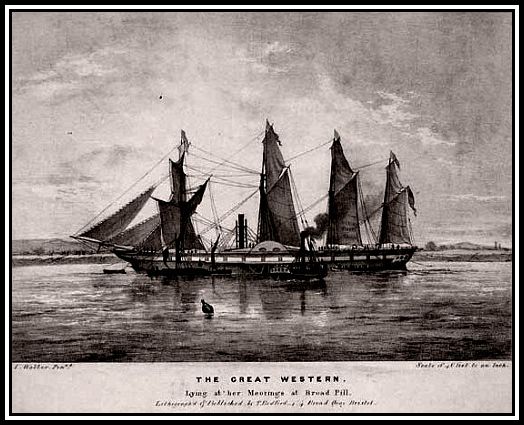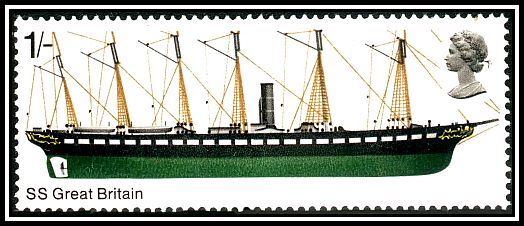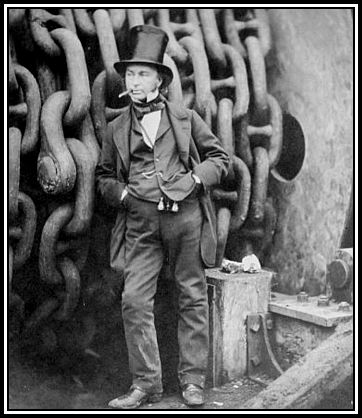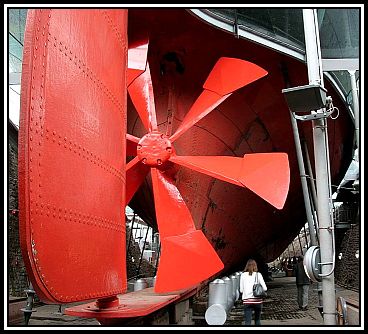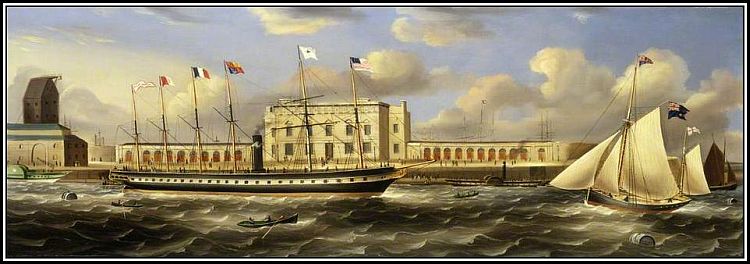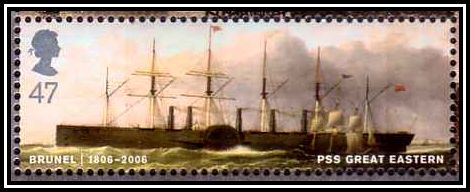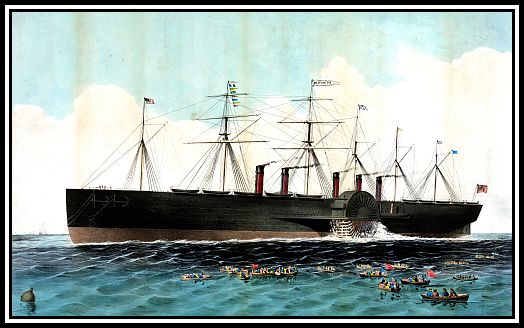ISAMBARD KINGDOM BRUNEL
Isambard Kingdom Brunel (1806-1859) was a Mechanical and Civil Engineer of great note and built the Great Western Railway, a number of steamships, dockyards, bridges, viaducts and tunnels. Brunel was, to say the least, innovative, and had a marked impact on transport and modern engineering.

Isambard Kingdom Brunel at his desk
-oOo-
PAGE THREE: THE BRUNEL STEAMSHIPS
It was Brunel’s vision that passengers would be able to travel from Paddington Station to New York, changing from the Great Western Railway to the SS Great Western steamship at the terminus in Neyland, West Wales.
SS Great Western was launched in July 1837 and made her Maiden Voyage on the 8th April, 1838 and made forty Transatlantic Crossings before being taken out of service in 1846. She was sold in 1847 and served as a mail-carrier until 1855 and then as a Troop Carrier. She was scrapped in October 1856.
SS Great Britain was launched in 1843 and was the largest ship built at the time; she left on her Maiden Voyage on 26th July, 1845 and was the first Iron-Hulled Steamship to cross the Atlantic. Later she served on the UK-Australia run and carried many immigrants there. In 1970, after many years of being left to rot in The Falkland Islands, she was salvaged and returned to Bristol where she was restored and is now maintained in the Dry Dock where she was built.
SS Great Eastern was the largest ship built at the time of launching in 1858; her Maiden Voyage was marred on the 6th September, 1859 due to an explosion that resulted in damage and the death of five seamen and a number of others injuries; she was later sold and laid Telegraph Cable between 1866 and 1878 and finally broken up between 1889 and 1890.
-oOo-
SS GREAT WESTERN
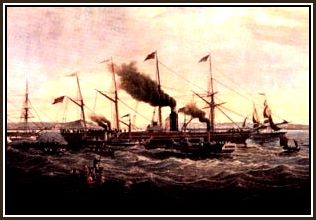 SS Great Western during her Maiden Voyage on 8th April, 1838
SS Great Western during her Maiden Voyage on 8th April, 1838
The SS Great Western was a oak-hulled, iron strapped Paddle Wheel Steamship and the first purpose-built Transatlantic Steamship. She was fitted with four masts for sails, which provided auxiliary propulsion and also maintained the ship on an even keel during rough weather to ensure that both Paddle Wheels remained in the water.
The SS Great Western was built in Bristol between 1836 and 1838 for the Great Western Steamship Company, which had been formed by Brunel and a number of Bristol businessmen in 1836 for the building of ships for the Bristol-New York sea route. She was the longest passenger ship in the world between her launching in 1837 and 1839 and was 234.91 feet (71.6 metres) in length and 57.71 feet (17.59 metres) across the Paddle Wheels (i.e. Beam).
The SS Great Western made her Maiden Voyage from Bristol to New York on the 31st March, 1838. Before she reached Avonmouth, a fire broke out in the engine room, which proved to result in minimal damage, however Brunel was injured and had to be put ashore and so missed the voyage. As a result of the fire, a number of passengers canceled their bookings and when she finally set off, only seven passengers remained on board.
The Steamship was the model for all successful wooden Atlantic Paddle-Steamers and was capable of making record Blue Riband voyages until 1843. Between 1838 and 1840, the SS Great Western averaged 16 days, 0 hours (7.95 knots) westward to New York and 13 days, 9 hours (9.55 knots) home.
Although the sailings of the SS Great Western were profitable, the Great Western Steamship Company suffered financial difficulties with the building of its second steamship, the SS Great Britain. Construction was prolonged and she was not ready to enter service until 1845. In September 1846, the SS Great Britain ran ashore because of a navigational error and was not expected to survive the winter. As a result the company’s fortunes declined and the directors decided to suspend all sailings of SS Great Western and went out of business.
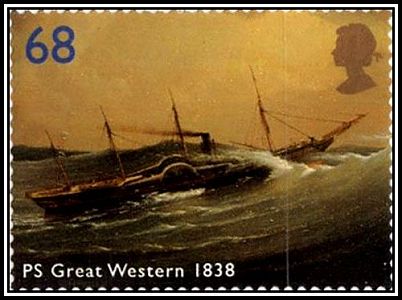 Postage Stamp of The SS Great Western from a Painting by Joseph Walter (1783-1856)
Postage Stamp of The SS Great Western from a Painting by Joseph Walter (1783-1856)
The SS Great Western Steamship made forty-five round trip voyages across the Atlantic between 1838 and 1846 until the Great Western Steamship Company ceased to be. Following this, the ship was sold to the Royal Mail Steam Packet Company in April 1847 and went into service on the Southampton–West Indies mail run. In 1855, she served as a troop ship during the Crimean War, and following her service, she was scrapped in 1856.
-oOo-
The SS Great Western Steamship inaugurated the era of the Trans-Atlantic Ocean Liner
-oOo-
SS GREAT BRITAIN
Once a transatlantic steamship service was shown to be commercially viable, The Great Western Steamboat Company put the SS Great Western into regular service between Bristol and New York. When the service became commercially successful enough, the Company agreed that a sister ship was needed. The same engineering team that were responsible for the building of the SS Great Western were brought together with Brunel designing the Steamship, which was to be built in a specially adapted Dry Dock in Bristol.
While working on the design for the new Steamship, two recently built steamships, the SS Rainbow and the SS Archimedes. visited Bristol and were to have a profound effect upon Brunel’s thinking:
In 1838, the largest Iron-Hulled ship in service, the SS Rainbow, visited Bristol. Brunel sent several of his associates to look at the ship and assess the value of the new material used in ship building. The associates returned with glowing reports as to the value of the Iron-Hull, which resulted in Brunel deciding to build the Hull of his new Steamship of iron.
Brunel presented the advantages of having an Iron-Hull as opposed to the traditional wooden type in his presentation to gain his colleagues support:
- Wood no longer as cheap as it was while iron was becoming more plentiful and cheaper;
- Iron Hulls were not subject to Dry Rot or Woodworm;
- were less bulky and lighter in weight; and
- of much greater structural strength;
- Wooden Hulls greater than 300 feet in length were subject to Hogging*, while Iron Hulls were not subject to this. As a result, the potential size of an Iron-Hulled ship was greater than that of a Wooden Hulled ship.
* Hogging: is the stress a ship’s Hull or Keel experiences, which causes it to bend upward. Stress is generated as the waves pass beneath the Hull; when it becomes too great, it results in the flexing of the Hull or Keel.
The SS Archimedes was the first Screw-Propelled Steamship and was built in 1839 by Francis Pettit Smith‘s Propeller Steamship Company. The ship was to exert a great influence on both the Royal Navy, who went on to adopt this mode of propulsion for its ships, and on future commercial ship building.
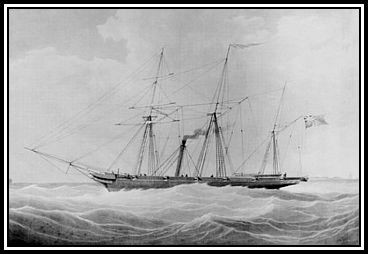 An Engraving of the SS Archimedes by C. Rosenburg and appears in A Short history of Naval and Marine Engineering, page 70, Edgar C. Smith (1905); printed for Babcock & Wilcox Ltd. by University Press, Cambridge
An Engraving of the SS Archimedes by C. Rosenburg and appears in A Short history of Naval and Marine Engineering, page 70, Edgar C. Smith (1905); printed for Babcock & Wilcox Ltd. by University Press, Cambridge
In 1840, the SS Archimedes visited Bristol. Brunel was greatly interested in this form of propulsion, as he was always looking for ways to improve a ship’s performance. He was allowed to subject the SS Archimedes to a series of tests employing a variety of especially built Propellers by Francis Pettit Smith in order to find the most efficient. Although, a four-bladed model proved to be the most efficient, the new Steamship was fitted with a six-bladed Propeller at the time of launching.
In order to convince his colleagues of the greater efficiency of the Screw Propeller over the Paddle Wheel, he offered the following advantages:
- The Screw Propeller was lighter than a Paddle Wheel and would be more economic to run;
- as it was lower in the Hull, it would lower the ship’s Centre of Gravity and make ship more stable in bad weather;
- while the depth of a Paddle Wheel depended on the weight of the cargo on board and the movement of the waves, a Propeller remained submerged at all times; and
- a Propeller offered less resistance as it moved through the water.
Brunel’s arguments were persuasive and in December 1840, the Company agreed to his proposals of building the ship with an Iron Hull and with a Screw Propeller. The changes were not without problems in that they proved both costly and prolonged the completion of the Steamship by nine months.
However, the SS Great Britain became the first ship to combine these features in a large ocean-going ship and was the first iron Steamship to cross the Atlantic in 1845 and with a time of 14 days.
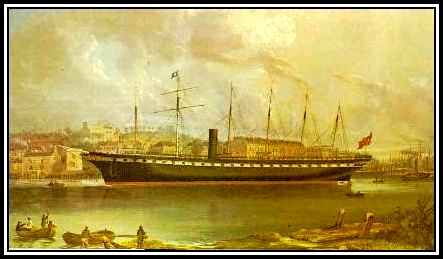 Painting of the SS Great Britain at Bristol in 1845 by Joseph Walter (1783-1856)
Painting of the SS Great Britain at Bristol in 1845 by Joseph Walter (1783-1856)
-oOo-
Work began on the construction of the SS Great Britain in July 1839 and was launched in on the 19th July, 1843. The ship was 322 feet (98 metres) in length, 50 feet 6 inches (15.39 metres) across her beam and with a Draught of 16 feet (4.9 metres). Propulsion was by one Screw Propeller with six blades and by six masts complete with sails allowing a speed of 10-11 Knots (12-13 mph). The ship was equipped to carry 360 passengers (which was increased to 730 at a later time) and 130 officers and crew and was able to carry 1,200 tons of cargo.
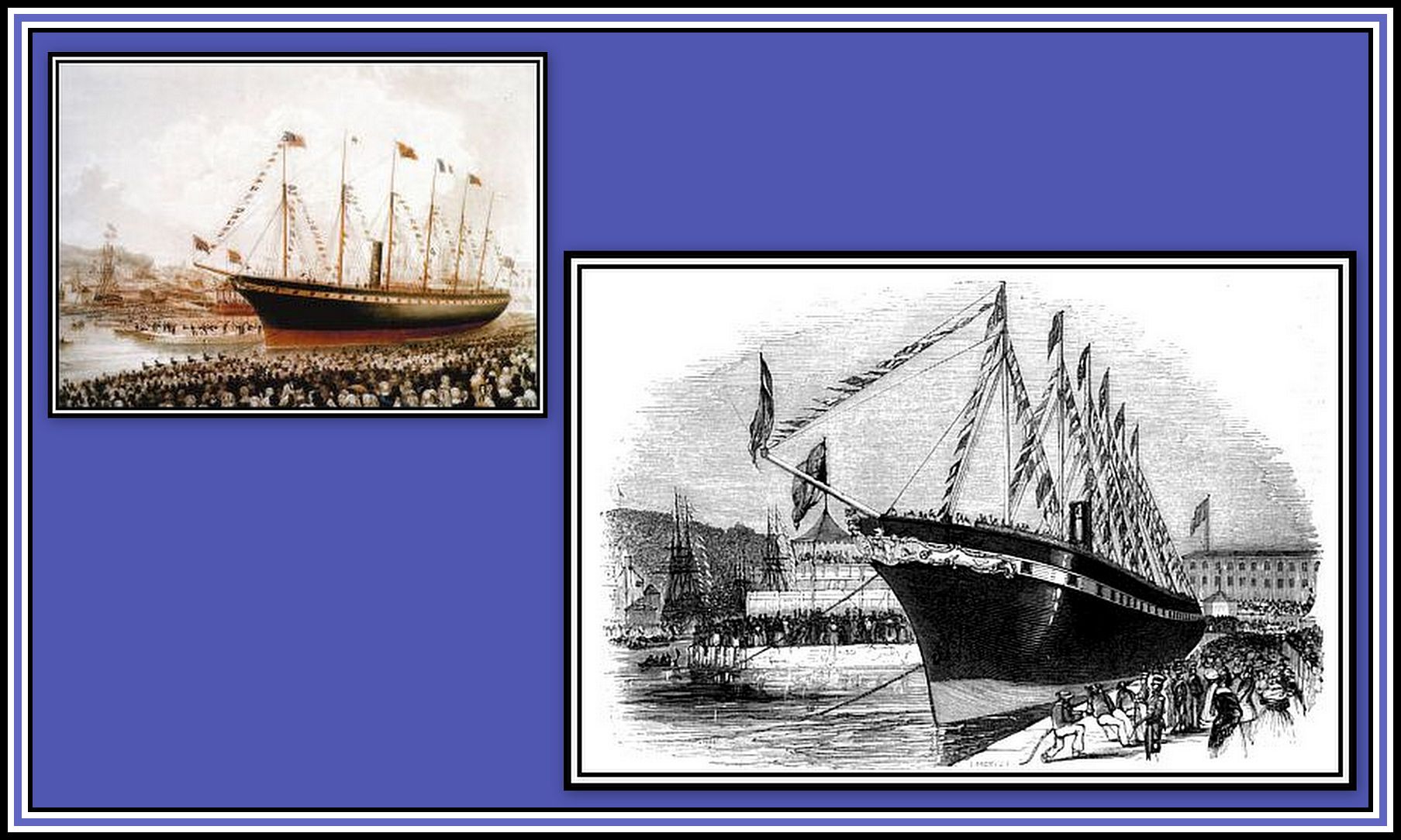 (Left) Detail of The Launching of the SS Great Britain by Joseph Walter; this picture is the copyright of the Lordprice Collection ; (Right) Engraving of the Launching by
(Left) Detail of The Launching of the SS Great Britain by Joseph Walter; this picture is the copyright of the Lordprice Collection ; (Right) Engraving of the Launching by
-oOo-
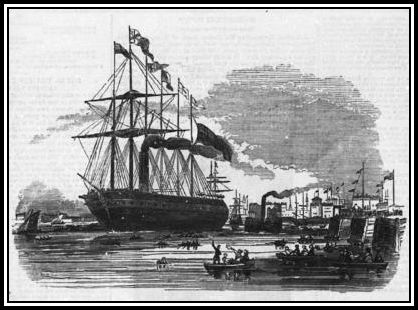 Engraving of the SS Great Britain leaving Blackwall; (c) National Maritime Museum
Engraving of the SS Great Britain leaving Blackwall; (c) National Maritime Museum
The SS Great Britain was to be towed to the River Thames following launching for the remainder of the work to be done. However, since the necessary modifications to Bristol Harbour had not been completed, the ship could not be floated out. Adding to the problem was that the Propeller engines had been added prior to the launch, causing the need to widen the ship, which then necessitated a deeper Draught.
As a result, the ship sat for more than a year before the Harbour authorities agreed to the finish the modifications and allow the ship to be floated out. However, difficulties continued, as the ship was unable to pass through the second set of lock gates. Through combined skill of the captain and Brunel’s direct intervention in removing the offending lock obstacles, the tug, SS Samson, successfully towed the ship into the River Avon.
SS Great Britain; (c) National Maritime Museum; Supplied by The Public Catalogue Foundation
-oOo-
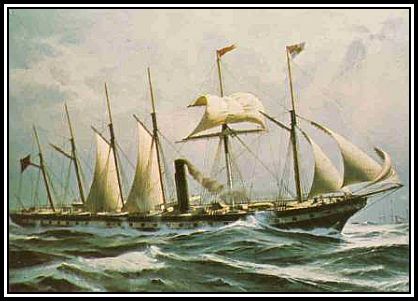 SS Great Britain by Keith Alastair Griffin (1927-)
SS Great Britain by Keith Alastair Griffin (1927-)
The SS Great Britain made her Maiden Voyage from Liverpool to New York on the 26th July, 1845, which was five years later than planned and with 45 passengers on board. Unfortunately the transatlantic crossings of the SS Great Britain suffered from a number of problems, which proved costly for the Company.
In 1846, on her third journey to New York, the SS Great Britain ran aground in Dundrum Bay on the northeast coast of Northern Ireland, as a result of a navigational error. Wooden ships in this location would have been lost, but due to its Iron Hull, the SS Great Britain was able to withstand the winter storms and survive. Brunel personally supervised the measures to protect the ship until she could be floated free and repaired and returned to service.
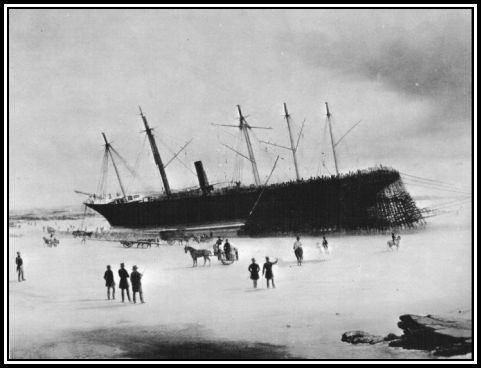 SS Great Britain aground in Dundrum Bay
SS Great Britain aground in Dundrum Bay
The cost of salvage and the refitting of the SS Great Britain proved too costly for the Company and sent it into bankruptcy. As a result the ship was sold and then refitted and returned to service between the U.K. and New York. However after only one round trip, she was sold to Antony Gibbs & Sons.
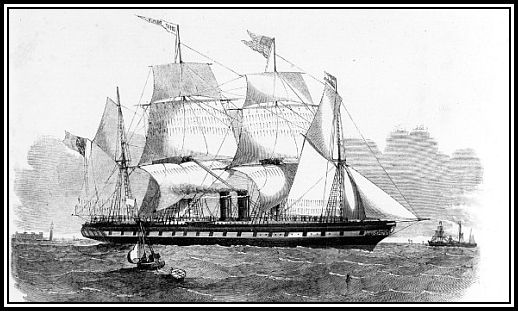 SS Great Britain during the First Trip to Australia
SS Great Britain during the First Trip to Australia
The new owners converted the SS Great Britain to a Steam-Powered Clipper and completed a third refit that allowed the number of passengers carried to be increased to 730. Following this, she entered service between the U.K. to Australia.
In 1852, the SS Great Britain made her first voyage to Melbourne carrying 630 emigrants. Her arrival caused great interest there and 4,000 people paid one shilling each to inspect her. Although the ship was not fast, she proved to be efficient and became the favourite Australian Emigrant Ship also bring the first England Cricket Team to tour there in 1861.
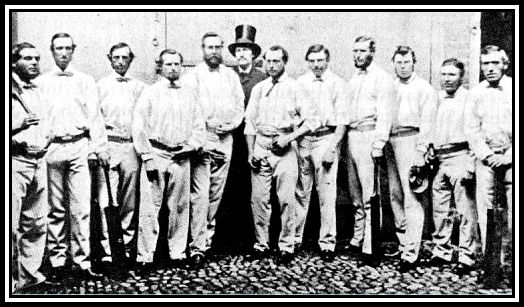 The English Cricket First XI that was the first to tour Australia
The English Cricket First XI that was the first to tour Australia
The SS Great Britain remained in service on the England–Australia route for almost 30 years with short interruptions to become a Troop Ship during the Crimean War and the Indian Mutiny.
In 1882, the SS Great Britain was converted into a Sailing Ship and employed to transport coal, however in 1886 a fire broke out on board and upon arrival at Port Stanley in the Falkland Islands, she was found to be damaged beyond repair. She was next sold to the Falkland Islands Company and used as a storage bunker for coal and wool until 1937. As a bunker, she supplied the South Atlantic fleet during the First World War and was scavenged in the Second World War to repair the HMS Exeter.
In 1933, after almost seventy years of service, the remains of the SS Great Britain was towed to Sparrow Cove, 3 1/2 miles from Port Stanley, where she was scuttled and abandoned.
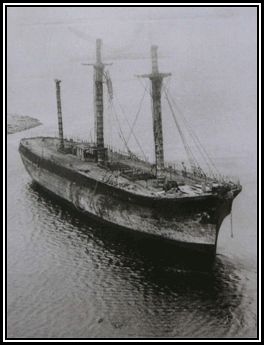 The abandoned remains of the SS Great Britain at Sparrow Cove
The abandoned remains of the SS Great Britain at Sparrow Cove
-oOo-
A group of people hit upon the idea to salvage the remains of the SS Great Britain and return her for restoration in the U.K. This was made possible by several large donations, including from Sir Jack Hayward and the late Sir Paul Getty, and was organised by the SS Great Britain Project and chaired by Richard Goold-Adams.
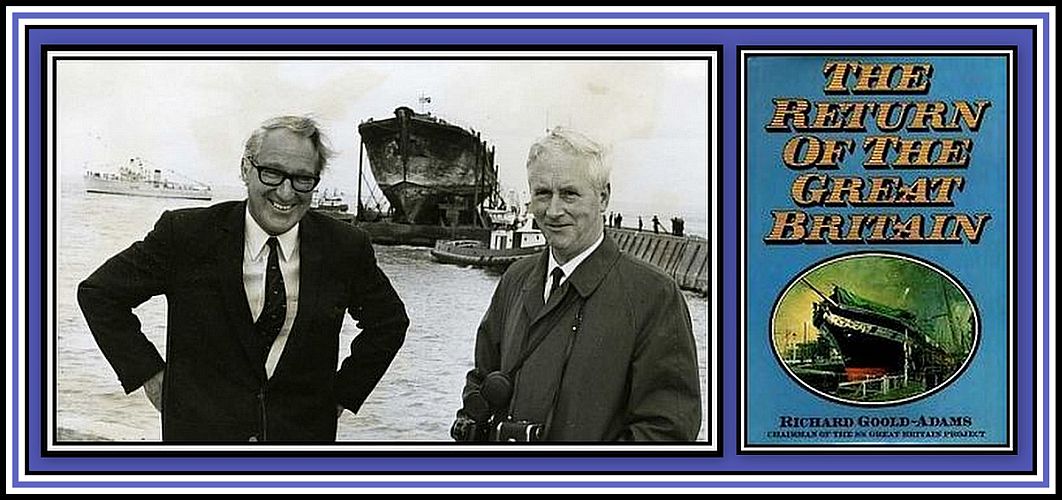 Sir Jack Hayward (1923-2015) & Richard Goold Adams; this photograph appears on the SS Great Britain website
Sir Jack Hayward (1923-2015) & Richard Goold Adams; this photograph appears on the SS Great Britain website
Click here
to watch the video, CHRONICLE -THE GREAT IRON SHIP,
the salvage of the SS Great Britain
-oOo-
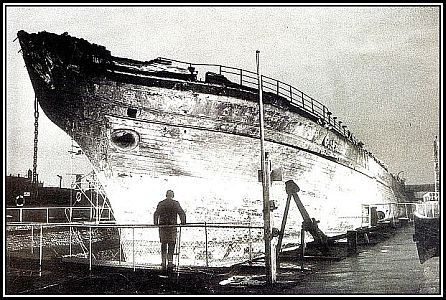 The Hull of the SS Great Britain; this photograph appears with the permission of Paul Townsend
The Hull of the SS Great Britain; this photograph appears with the permission of Paul Townsend
-oOo-
In 1969, the naval architect Ewan Corlett helped organise a rescue mission to bring the remains of the SS Great Britain back to the U.K. Inspection of the Hull revealed a large crack on one side, which needed to be repaired before it could be returned home. A large pontoon, the Mulus 3, was submerged beneath the Hull and then raised thereby bringing it out of the water. Once this was achieved, the holes and cracks were covered and made water tight with mattresses, which had been donated by Falkland Islanders.
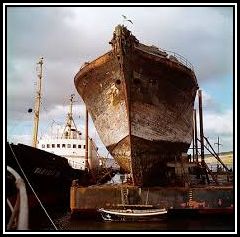 Aboard the Pontoon, Mulus 3, in the Falkland Islands
Aboard the Pontoon, Mulus 3, in the Falkland Islands
Once made water tight and secured well, the pontoon and its cargo were towed by Varius II from the Falkland Islands to Montevideo. and then across the Atlantic to Bristol. which took fours months. However the pontoon and cargo were not, as yet, home and dry, for another great obstacle was waiting on the River Avon.
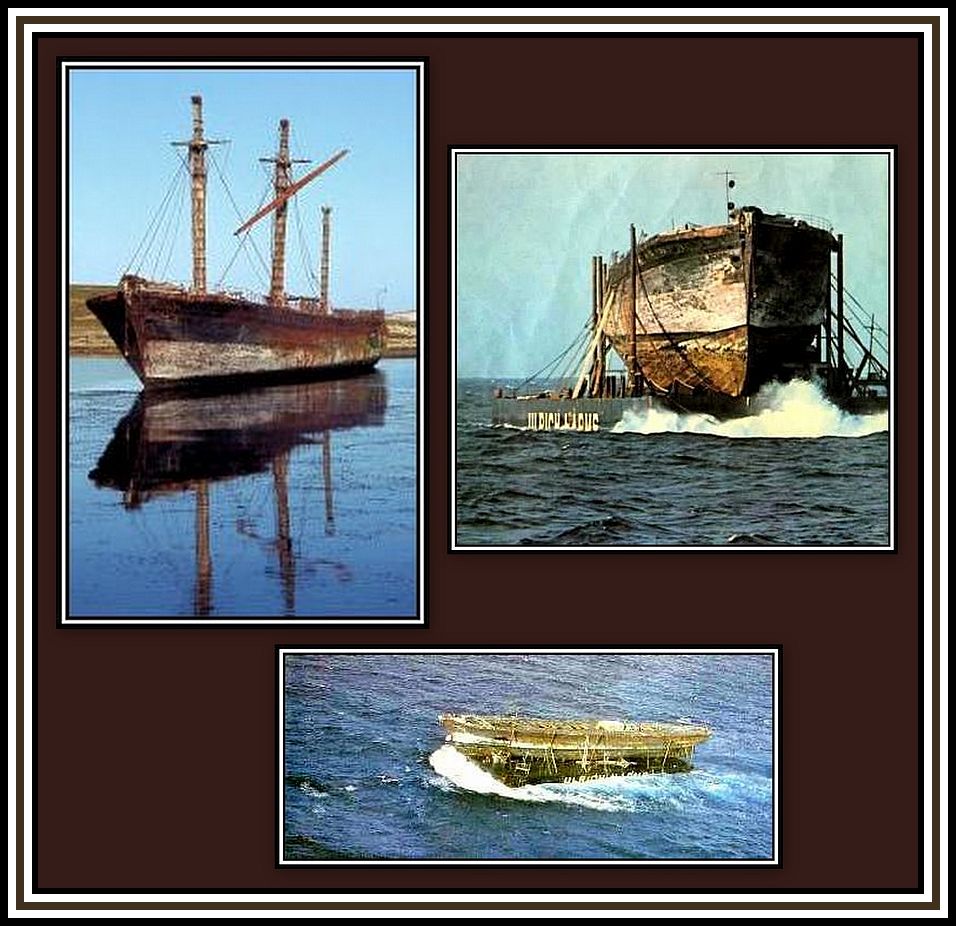 The Remains of the SS Great Britain aboard the Mulus 3 being towed
The Remains of the SS Great Britain aboard the Mulus 3 being towed
-oOo-
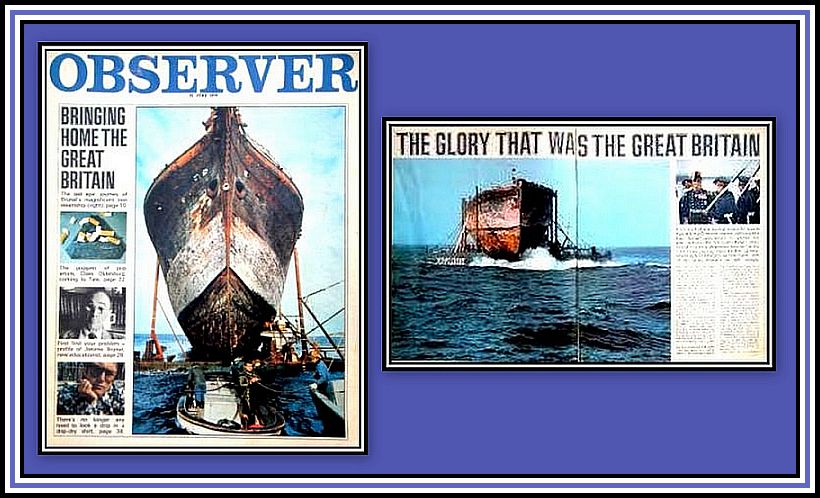 From The Observer Sunday Magazine, 1970
From The Observer Sunday Magazine, 1970
Click here
to read the full article
-oOo-
Getting the Hull and pontoon from Avonmouth on the Severn Estuary to the Dry Dock at Bristol Harbour where the Ship had been built, would not prove an easy matter, since it had to be maneuvered around the horseshoe bend of the River Avon, which was a daunting task!
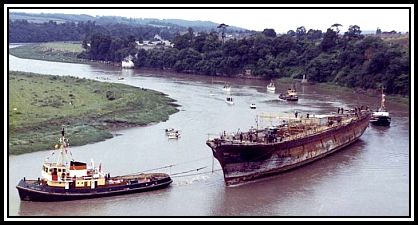 Towing the Pontoon and Cargo around the Horseshoe Bend of the River Avon
Towing the Pontoon and Cargo around the Horseshoe Bend of the River Avon
The skill of the tug keepers was such that on the 19th July,1970, exactly 127 years after her launching in 1843, the SS Great Britain was returned to the dock where she had been built.
During the Ship’s passage along the River Avon, she passed under the Clifton Suspension Bridge, another Brunel design.
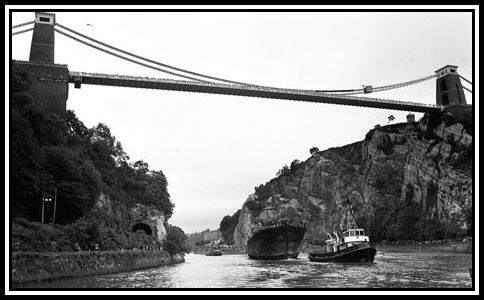 SS Great Britain being towed under the Clifton Suspension Bridge in 1970; this photograph is owned by Popperfoto/Getty Images; awaiting permission to reproduce it here; it appears in The Guardian on the 19th July, 1970
SS Great Britain being towed under the Clifton Suspension Bridge in 1970; this photograph is owned by Popperfoto/Getty Images; awaiting permission to reproduce it here; it appears in The Guardian on the 19th July, 1970
The Ship had to wait for two weeks in the Cumberland Basin for a tide to be high enough to take her through the locks to the dock. The dock had been abandoned for over one hundred years, but Bristol Borough Council had had it restored in preparation of the return.
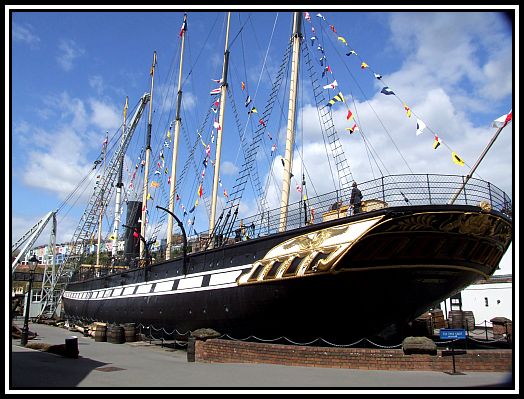 SS Great Britain Restored; this photograph is credited to Mandy Reynolds, coutesy of the SS Great Britain Trust
SS Great Britain Restored; this photograph is credited to Mandy Reynolds, coutesy of the SS Great Britain Trust
Between then and 2005, the SS Great Britain was returned to its original glory and today it is moored sits in its Dry Dock, which is now Grade II* listed. The Dock and the Ship are now available to the public and many have visited them and will hopefully continue to do so.
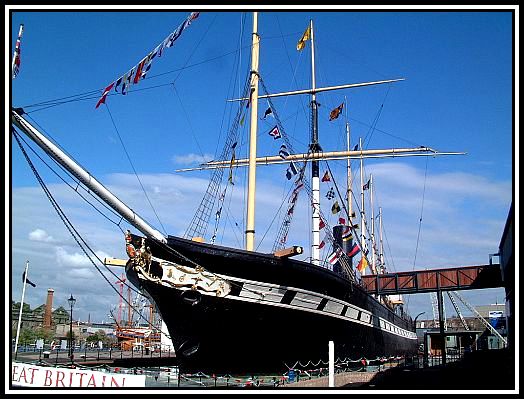 Bristol MMB 43 SS Great Britain; this photograph was taken by
Bristol MMB 43 SS Great Britain; this photograph was taken by
-oOo-
The following photographs of the SS Great Britain at Bristol are credited to Mr. David Noton and appear here through the courtesy of the SS Great Britain Trust. Special thanks are given to Mr. Dominic Rowe of The Trust for his help and consideration in this matter.
-oOo-
Click here
to watch the video, Brunel’s SS Great Britain
The SS Great Britain was designated as a Historic Mechanical Engineering Landmark by the American Society of Mechanical Engineers and is only the fourth such designation awarded outside the U.S. In addition, a number of awards have been bestowed on the SS Great Britain including the IStructE Award for Heritage Buildings (2006), the Gulbenkian Prize (2006) for Museums and Galleries, The Crown Estate Conservation Award (2007), the European Museum of the Year Award, the Micheletti Prize for Best Industrial or Technology Museum, and in 2008, the Sandford Award for Heritage Education.
SS GREAT EASTERN
Brunel believed that it was possible to build a large ship capable of traveling to Australia without the need of refueling and compete with the fastest Clippers that currently dominated the route. Brunel and John Scott Russell, an experienced naval architect and ship builder, approached the The Eastern Steam Navigation Company in July 1852 with a plan to build large Steamships. The Company had been formed in January 1851 with the aim of exploiting the increase in trade and emigration to India, China and Australia.
Brunel proposed that propulsion of such a large Steamship would be by a combination of a single Propeller and Paddle Wheels together with sails for auxiliary power and have a capacity to carry 4,000 passengers. Following consideration of their proposal, the Company announced that it would support it and appointed Brunel as Engineer of the project.
-oOo-
For the aim of The Eastern Steam Navigation Company’s to come to fruition, it needed a subsidy, which is a form of financial aid or support. At the time, an attractive subsidy would be a mail contract from the British General Post Office. Unfortunately, in March 1852, despite its efforts, the British Government announced that it was awarding their mail contracts to other companies and not to The Eastern Steam Navigation Company despite its tender being lower. As a result, the Company was left without financial support.
-oOo-
The Steamship was built by J. Scott Russell & Company at Millwall in London. Apparently, Brunel enjoyed referring to her as the Great Babe. Work began building the ship in 1854, and due to its extreme length, it had to be built sideways, and later launched in this manner.
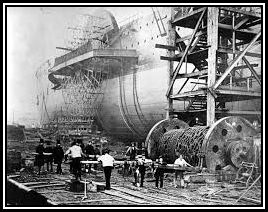 SS Great Eastern Steamship during building
SS Great Eastern Steamship during building
The Steamship was the largest ship built at the time of launching in 1858 with a length of 692 feet (211 metres) and a maximum width of 82 feet (25 metres) and a weight of 22,500 tons. She was one of the few ships built with five funnels, which was later reduced to four.
The Paddle-Wheels were 56 feet (17 metres) in diameter and the four-bladed screw-propeller was 24 feet (7.3 metres) across. The power came from four steam engines for the Paddles with an additional engine for the Propeller. The ship was equipped with six masts for sails. However, the sails were proven to be unusable at the same time as the Paddle-Wheels and Propeller since the exhaust from the funnels set them on fire. The maximum speed that the ship was able to achieve was 24 kilometres/hour (13 Knots).
The Hull of the ship was made of iron and was the first ship to be built with a Double-Skinned Hull. This feature was not immediately adopted for several years, but is now a compulsory feature in all ships built today for reasons of safety.
-oOo-
Building the ship was not without its difficulties. Costs rose and in February 1854, the J. Scott Russell & Company suspended all payments to its creditors and dismissed all workmen. As a result, The Eastern Steam Navigation Company had to look elsewhere to complete the building. Work was resumed in May 1854, but took longer than expected to complete.
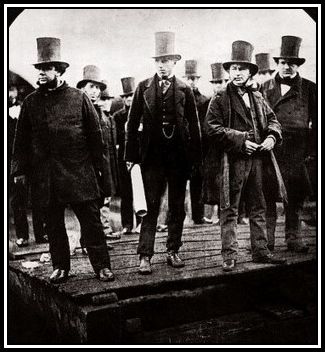 The First Attempt to Launch the SS Great Eastern on the 3rd November, 1857; this photograph appears on John Speller’s Web Pages – Brunel’s Steamships – SS Great Eastern;
The First Attempt to Launch the SS Great Eastern on the 3rd November, 1857; this photograph appears on John Speller’s Web Pages – Brunel’s Steamships – SS Great Eastern;
From Left to Right: John Scott Runnel, Henry Wakefield, Isambard Kingdom Brunel & Lord Derby (attempts to contact Mr. Speller have failed)
The SS Great Eastern was launched on the 31st January, 1858, but not without difficulty. Unfortunately, Brunel did not witness the ship take her Maiden Voyage, which eventually took place on 6th September, 1859, during which she was damaged by an explosion, which resulted in the death of five seamen and a number of others injuries. At the time Brunel was ill and died soon after on the 15th September, 1859.
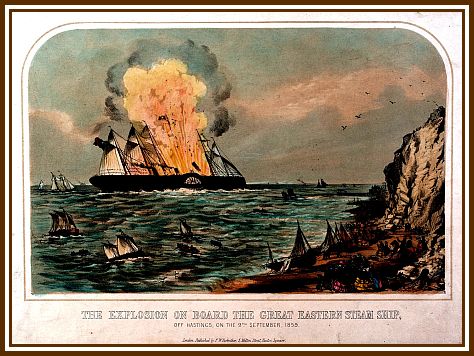 The Maiden Voyage of the SS Great Eastern on the 6th September, 1859 and the explosion while close to Hastings in the English Channel
The Maiden Voyage of the SS Great Eastern on the 6th September, 1859 and the explosion while close to Hastings in the English Channel
-oOo-
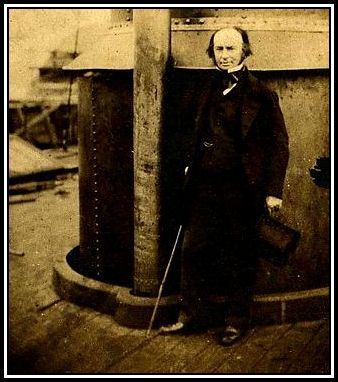 Isambard Kingdom Brunel aboard the SS Great Eastern one week before his death from a stroke
Isambard Kingdom Brunel aboard the SS Great Eastern one week before his death from a stroke
-oOo-
Brunel had planned for the SS Great Eastern to make voyages between the U.K. and Australia. However it only served as a passenger liner between the U.K. and the U.S. from 1860 to 1863 and these voyages were plagued with difficulties.
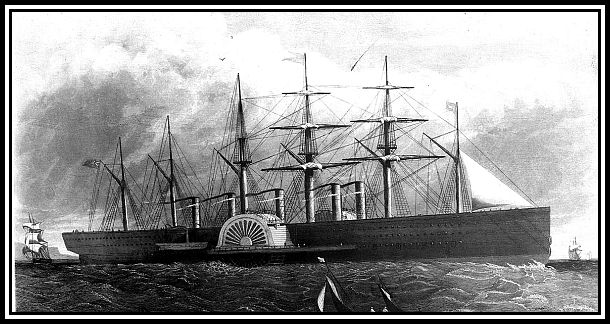 An Engraving of the SS Great Eastern – artist unknown
An Engraving of the SS Great Eastern – artist unknown
-oOo-
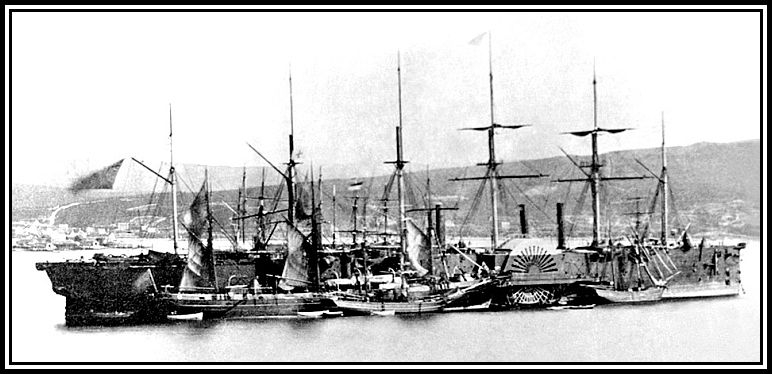 SS Great Eastern, 1866; this photograph was taken by Robert Edwards Holloway (1850-1904)
SS Great Eastern, 1866; this photograph was taken by Robert Edwards Holloway (1850-1904)
Following it use as a passenger liner, the SS Great Eastern was chartered in 1864 to the newly formed Telegraph Construction & Maintenance Company to lay Transatlantic Telegraph Cable. The ship underwent a number of modifications in order to make space for the cable. Such changes included the removal of the fourth funnel and some boilers together with a number of passenger rooms and saloons. Between 1866 and 1878, the SS Great Eastern laid over 30,000 miles (~48,000 kilometres) of telegraph cable including that from Brest, France to Saint Pierre & Miquelon (close to Newfoundland) in 1869, and that from Aden to Bombay (1870).
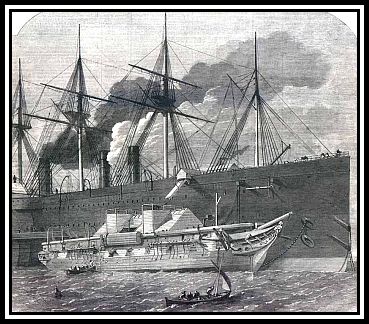 SS Great Eastern laying Telegraph Cable in 1865 near Sheerness
SS Great Eastern laying Telegraph Cable in 1865 near Sheerness
On the last occasion that the SS. Great Eastern traveled from England to Bombay via the Cape of Good Hope, she carried an enormous displacement of 32,724 tons that required a draft of 34 foot 6 inches, which was remarkable for the time.
-oOo-
Despite efforts to return the ship to passenger service, these failed. The ship spent her last working years as a Showboat, a floating Concert Hall and Gymnasium and also acted as an advertising hoarding by sailing up and down the River Mersey for Lewis’s Department Store.
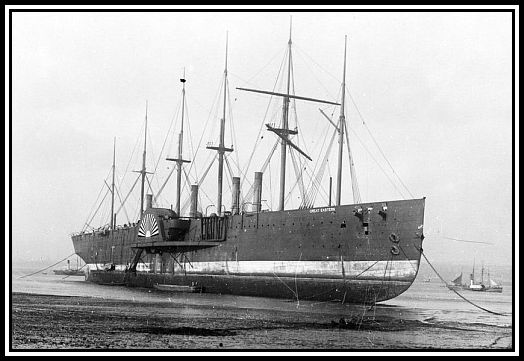 SS Great Eastern before being broken up; this photograph was taken by Allan C. Green (1878-1954) and is present at the State Library of Victoria, Melbourne, Australia
SS Great Eastern before being broken up; this photograph was taken by Allan C. Green (1878-1954) and is present at the State Library of Victoria, Melbourne, Australia
Following this, the ship was sold and broken up between 1889 and 1890 in Liverpool. This was a sad ending for such a magnificent ship that was far advanced for its time.
Footnote: The Liverpool Football Club purchased the top mast of the SS Great Eastern and uses it still as a flagpole and it may be seen at the Kop end of the grounds.
-oOo-
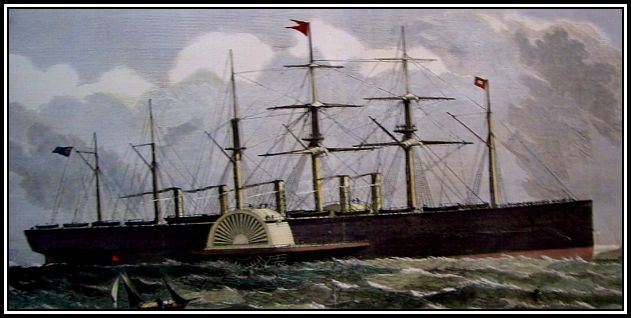 SS Great Eastern; this picture appears on John Speller’s Web Pages – Brunel’s Steamships – SS Great Eastern (attempts to contact Mr. Speller have failed)
SS Great Eastern; this picture appears on John Speller’s Web Pages – Brunel’s Steamships – SS Great Eastern (attempts to contact Mr. Speller have failed)
——oooOOOooo——
Click on each of the following links to read more of
Mr. Brunel’s remarkable achievements
HOME PAGE
-oOo-
PAGE ONE: THE EARLY YEARS
-oOo-
PAGE TWO: THE GREAT WEST RAILWAY
-oOo-
PAGE FOUR: THE BRUNEL BRIDGES
-oOo-
PAGE FIVE: THE BRUNEL MEMORIAL
——oooOOOooo——
Readers can TWEET their LIKES & DISLIKES to me at
or
make comments on the Website’s FACEBOOK PAGE
or
consider leaving a Comment below.
——oooOOOooo——
ACKNOWLEDGEMENTS
I would like to thank Mr. Paul Bland for allowing his photographs to appear here.
I would also like to thank Ms Annie Barnes for her help and consideration and for allowing some of her photographs to appear here.
Finally, I would like to thank Mr. Dominic Rowe of the SS Great Britain Trust for his help and consideration and for allowing some of the Trust’s photographs (credited to Mr. David Noton) to appear here.
——oooOOOooo——
Click here to GO to A SERIES OF WALKS ALONG THE EMBANKMENT Home Page
——oooOOOooo——
Click here to go to PART FOUR: VICTORIA EMBANKMENT GARDENS
——oooOOOooo——
Click here to RETURN to the TABLE OF CONTENTS
——oooOOOooo——


